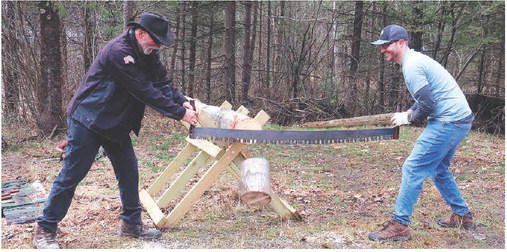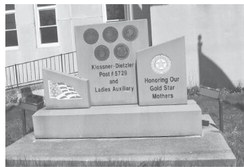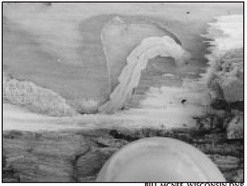Clark County board approves the purchase of 80 acres in town of Seif
By Neal Hogden, The Tribune Phonograph The Clark County Board of Supervisors passed a resolution at its meeting on March 21 that would allow the county parks and forestry department to pursue the purchase of 80 acres of woodland in the town of Seif.
John Wendorski, assistant forest administrator of the Clark County Parks and Forestry Department, gave a presentation to the board explaining the resolution that would give the department the authority to work on acquiring the land in question.
He explained that there are two 40-acre parcels of land in the town of Seif, southwest of Willard, that are land-locked by county forest. The parcels are only accessed through a permit from the Clark County Forestry and Parks Department. Otherwise, they do not have legal access.
Wendorski explained to the board that the county forest land acquisition policy states that lands are considered higher priority for acquisition when they meet some of the following seven requirements: - Lands that improve management efficiencies, such as reducing the length of private-public boundaries or improve access to existing county forest.
- Lands that will increase the county’s inventory of productive timberland and provide a consistent source of raw material to the forest products industry.
- Lands that conserve surface and groundwater, maintain undeveloped shoreline and increase public access to water features.
- Lands that are threatened by private development or fragmentation that may result in a long-term negative impact on adjacent public lands.
- Lands adjacent to county forest that have very diffi cult access due to terrain or natural feature barriers or are landlocked.
- Lands that will provide for priority trail connections and expansions or reduce or eliminate existing user confl icts. - Lands that contain threatened or endangered plants, animals or communities; or other natural features considered to be of high conservation value.
Wendorski said these specific parcels fell into four out of the seven policy points and thus would be of interest to the county. He focused on the timber that could be logged now and in the future, which would not only help offset the cost of purchasing the land, but potentially give the county a profit on the transaction. He noted that there were 20 acres of red maple trees, 42 acres of oak trees and about three acres of predominantly aspen trees that could be harvested for profit.
After a board member asked about the timber and how much the county could make by selling the wood, Wendorski said the project could potentially be covered using revenues from a timber sale soon after purchasing the property.
“We feel like, if we purchased the property, we could very quickly go in, set a timber sale. We could potentially recoup, conservatively, the money that we would draw out of our fund balance,” Wendorski said.
Financing the project He said the current landowners are wanting a price of $2,500 per acre, which would put the total purchase price at an estimated $200,000. Wendorski estimated the closing costs, appraisal and other miscellaneous costs to be around $7,000 for a total of $207,000. This total number was used as an estimation as the county, The Nature Conservancy and the landowners would be negotiating on the price of the land after an appraisal was done on the property.
Wendorski said the funding for the purchasing agreement would be slightly complicated. He said the landowners were motivated to sell the property sooner rather than later and other interested parties had already been out to look at the property. Wendorski told the board the project would largely be partially funded using a Knowles-Nelson Stewardship Grant. If approved, the grant would reimburse Clark County for up to 50% of the purchase price and administrative fees.
Wendorski said he pitched this project to a DNR public land specialist who oversees the Knowles-Nelson Stewardship Grant program. Wendorski said the feedback the department was given stated there’s a “99-percent chance” of the grant application being approved for this particular project.
He said although the grant would help, the county would need to bridge the gap for funding until the department could properly budget for the project in 2025. He then introduced Hannah Butkiewicz from The Nature Conservancy (TNC), who told the board TNC would be willing to purchase the property from the landowner and hold it until the county could pull the funds together in 2025. She said TNC is a global nonprofit organization whose mission is “to conserve all lands and waters in which life depends on.”
“It seems to work for all parties involved if we include The Nature Conservancy just because of the time difference between what the [landowners] would like to do and what our department would like to do,” Wendorski said.
He said if the Knowles-Nelson Stewardship Grant covered half of the $207,000 total cost to purchase the land, then the forestry and parks department would use $48,586 currently in its county land acquisition fund. This is a fund that has been set up for acquisitions just like this one.
He said the rest of the balance would be taken out of the forestry and parks fund balance.
“Between the use of our land acquisition fund and our forestry fund balance, there will be no impact to the levy for Clark County in 2025. That’s kind of the take home message here,” Wendorski said.
During his presentation, Wendorski noted that current timber revenues will reduce the Clark County tax levy by $1.86 million in 2024 and the purchase of the two parcels would add to that revenue in the long run.
“As a department, and our committee supported the fact that, we think this is an excellent opportunity for us to clean up some in-holdings,” Wendorski said.
Board questions Board member Duane Boon had questions for Wendorski regarding the financial viability of purchasing the property.
“Are you aware that the Knowles-Nelson Stewardship Funds were cut in the last budget a few years ago from $60 million to $23 million?” Boon asked.
Wendorski said he knew that the budget was cut, but said the portion of money the county would be seeking was not affected by those budget cuts. He said the pot of money the county would be seeking has stayed at about $7-9 million year after year.
Boon proposed an alternate option. He said if the county took the $100,000 they were proposing to spend on the purchase of land and put it in a bank account to earn 5% interest over 20 years, they would make $50,000. By estimating that the county makes on average $20-$30 per acre harvesting timber per year, he said the county would only make $48,000 in timber by purchasing the land and managing the forest.
“It’s kind of a no-brainer. It’s a poor investment,” Boon said. “Why would we want to do that?”
“Looking at generalizations with every 20 years like you are, that’s a legitimate way of looking at the project,” Wendorski said. “But if you look at the details of this project, we are looking at a much quicker return.”
“Like I said, I think we can get almost $50,000 on the first harvest and we’d be back in there in 10 years to do a shelter wood harvest and potentially get another $30,000-$50,000 and then we have to take a final fell and that’s another 10 years,” Wendorski said. “So really, in the first 20 years, we, off of this particular property, will more than double what you’re indicating.”
Boon voiced one final comment, stating the property would not be taxable if it was owned by the county.
“Being on the public property committee, our goal for taxable property is to get it sold to private people so it can get back on the tax roll so we are making money,” Boon said. “Now, we’re taking this off the tax roll because it’s county owned.”
Wendorski said the county isn’t actively looking to purchase land, in turn, taking land off the tax roll, but instead only buys it when it has to, which is why he referred to the county land acquisition policy at the beginning of his presentation.
Boon said there are many other land-locked parcels within the county forest area and asked if the county would be pursuing all of those as well.
Wendorski said most of those parcels have town road access in some shape or form so there is less of a basis, from the county’s standpoint, to acquire those properties.
Another question arose about the new county board and what effect that might have on the board’s ability to pass the budget item for funding the project in 2025. Wendorski said every time there is a new county board member voted in, the forestry and parks department invites them in to see what they do and what projects they are working on. He said he would be more than willing to help educate them on this specific project.
The board voted to pass the resolution, allowing TNC to attempt to purchase the property. The resolution then states the county will have the ability to enter into a purchasing agreement with TNC if they are able to purchase the property.
Ryan Ashbeck, Fritz Garbisch and Boon voted down the resolution while 22 other board members voted to approve the resolution.



